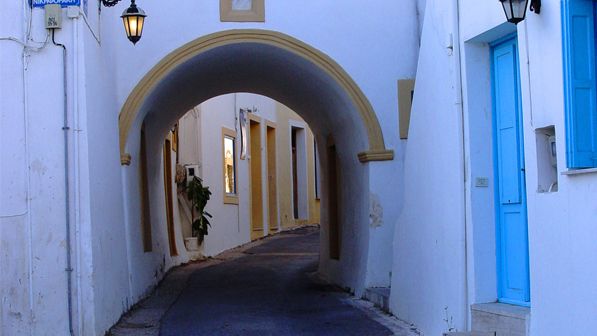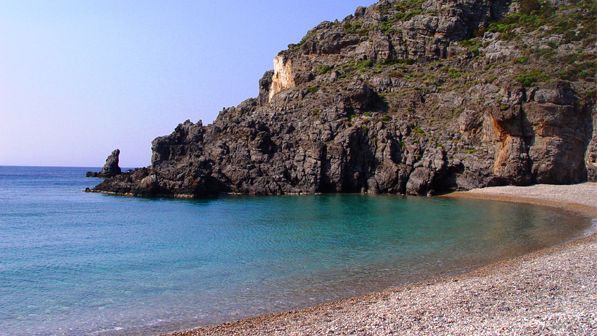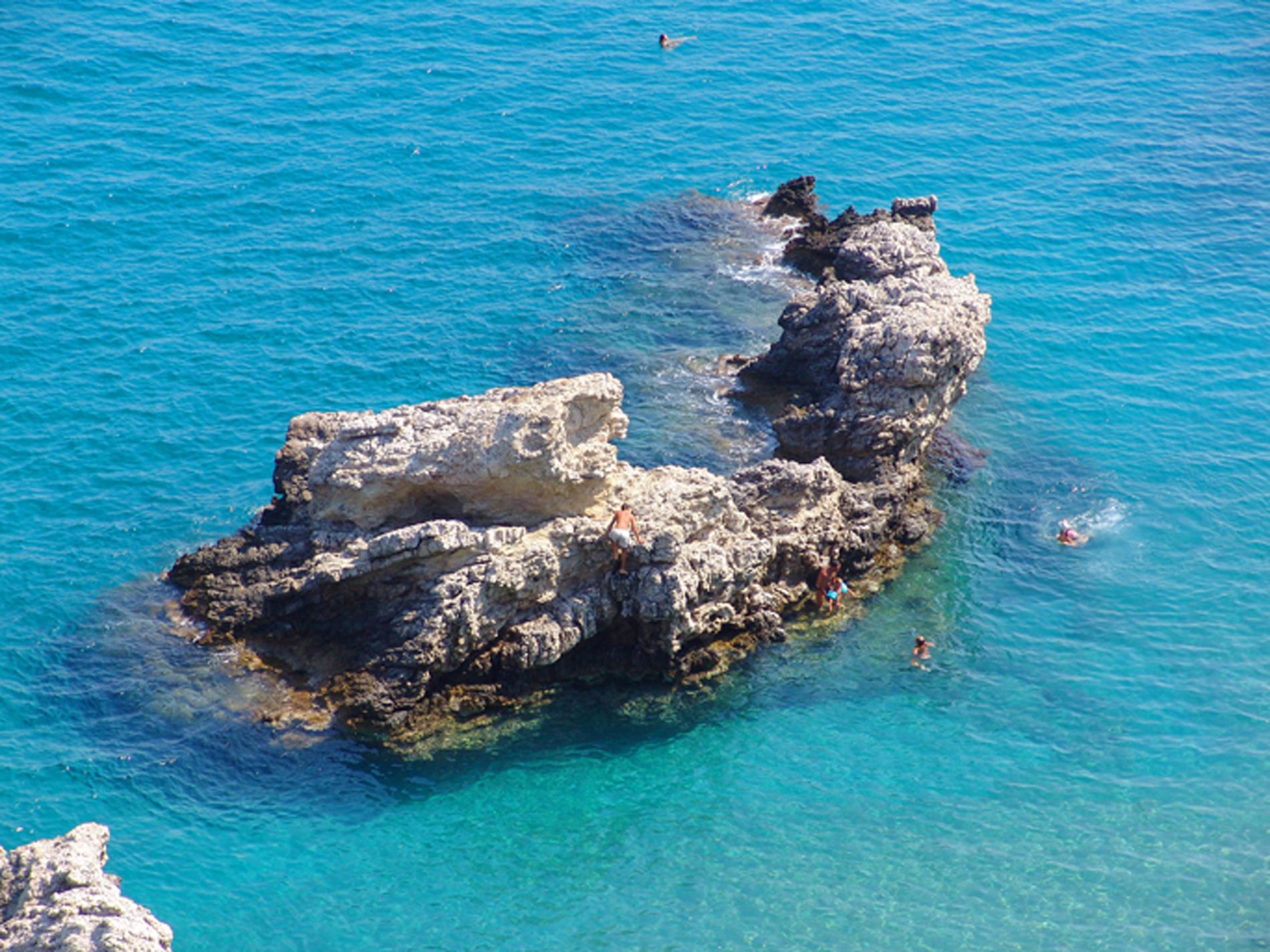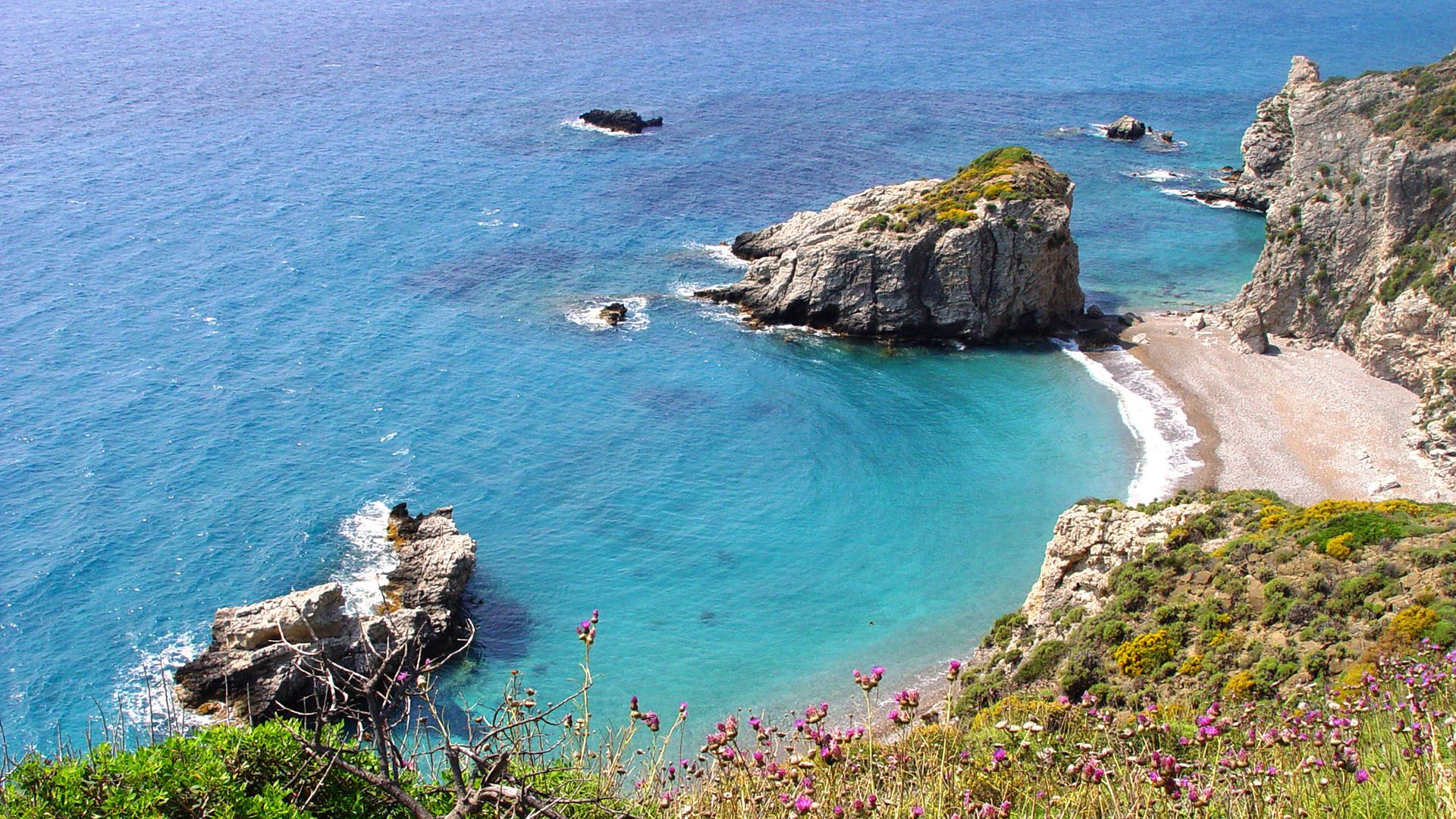Kythera & Antikythera
Kythera & Antikythera
The island of Kythera might be the most distant among the Attica Islands, yet it has numerous loyal visitors. Located in between Crete and the southern Peloponnese, Kythera is situated at the junction of where the Aegean Sea, the Ionian Sea and the Cretan Sea meet.
It has always been an important crossroads for the eastern Mediterranean. As indicated by archaeological findings in the island’s caves, Kythera’s original inhabitants settled here during the Neolithic period in the sixth millennium BC.
Throughout the island’s turbulent history, its strategic location has been claimed by many civilizations, including the Minoan, the Mycenaean and the Phoenicians, who have all made Kythera one of the most important commercial hubs in the Mediterranean.
The island’s rule changed many times over the centuries, until the Byzantine conquest in the 12th century AD, when the town of Ag. Dimitrios (today called Paleohora) was built. Although the rule of Kythera eventually fell to the Venetians, the island’s ancient religious culture was preserved for many centuries.
After the fall of the Venetians in 1797, the island’s rule passed from the Turks to the French and then to the British, before it was united with the other islands of the Heptanese in 1814 and finally with the state of Greece in 1864. History has left its indelible mark on this ancient island and a trip to Kythera’s beautiful beaches, lush green landscapes and incredible past is not to be missed.
According to Greek myth, Aphrodite, the goddess of love, was born on Kythera. As such, it would be difficult not to fall in love with the island’s picturesque charm and friendly atmosphere: the evergreen mountains, the whitewashed alleyways of its villages, the flowered courtyards and the traditional cafés under the large plane trees.
There are so many places worth exploring on the island such as the blue-green crystal clear waters of Kaladi Beach and the little cave at exotic Diakofti, the ruins of the fortified town of Paleochora or the medieval village of Milopotamos, well-known for the Neraida waterfall and the 22 watermills.
The numerous fans of Kythera from Greece and from other parts of the world who fell in love with this unique and very special island, keep coming back year after year, while some even decided to stay for good.
Antikythera – A place of serenity
Tiny Antikythera, south of Kythera, with a population of about 20 residents – but increasing during the summer months – is a haven for visitors seeking tranquillity and relaxation in a place with unspoiled natural beauty and fascinating hiking routes.
To put things into perspective, the island’s phone line was set up in 1999 and a majority of the work done on the island is done so in traditional fashion. Despite the slower mode of daily life, the residents are always smiling, polite and hospitable.
Migratory birds are long-time regulars of Antikythera that appreciate its location at the junction of the Aegean, Ionian and Cretan Seas for a quick stop before continuing their journey.
For this reason, the Hellenic Ornithological Society has placed a monitoring station on the island for birdwatchers. This place gained world fame thanks to an ancient shipwreck holding treasures of great value such as the Antikythera Mechanism, mankind’s oldest computer.
Excavations have recently uncovered well-preserved ancient artefacts in the northern part of the island, at the castle (Kastro), just above the Xeropotamos cave. In the summer, a host of archaeology students visit the site and take part in the excavations.
General information about Kythera & Antikythera Islands
Easily accessed by boat from Piraeus, Gytheion, Neapolis and Kissamos in Crete, the mountainous island of Kythera is the perfect summer destination for relaxing, carefree holidays in a beautiful, romantic environment.
The island’s capital Hora, with its imposing medieval castle, offers visitors an unforgettable view of the city port Kapsali. The island is quite large, being home to more than 60 villages, with idyllic beaches, tasty food and myriad attractions. The eclectic cultural and architectural mix is obvious in every corner of this island, with its Venetian allure still on display in its narrow pathways.
INFORMATION
Port Phone: (+30) 27360 34222
Police Phone: (+30) 27360 31206
Hospital Phone: (+30) 27360 33325
Website: kythira.gr
How to get there
Kythera
Athens to Kythera
Distance by plane (Athens International Airport): 1 hour.
Piraeus to Kythera (summer period, twice per week)
Distance by Ferry Boat: 6,5 hours.
Neapolis (southern Peloponnese) to Kythera
Distance by Ferry Boat: 2 hours.
Gythio (Peloponnese) to Kythera
Distance by Ferry Boat: 2 hours and 25 minutes.
Kissamos (Crete) to Kythera
Distance by Ferry Boat: 3 hours and 45 minutes.
Antikythera
Piraeus to Antikythera
Distance by Ferry Boat: 8 hours and 40 minutes.
Kythera to Antikythera
Distance by Ferry Boat: 1 hour and 30 minutes.
Kissamos (Crete) to Antikythera
Distance by Ferry Boat: 1 hour and 45 minutes.
Neapolis (southern Peloponnese) to Antikythera
Distance by Ferry Boat: 4 hours.
The island of Kythera might be the most distant among the Attica Islands, yet it has numerous loyal visitors. Located in between Crete and the southern Peloponnese, Kythera is situated at the junction of where the Aegean Sea, the Ionian Sea and the Cretan Sea meet.
It has always been an important crossroads for the eastern Mediterranean. As indicated by archaeological findings in the island’s caves, Kythera’s original inhabitants settled here during the Neolithic period in the sixth millennium BC.
Throughout the island’s turbulent history, its strategic location has been claimed by many civilizations, including the Minoan, the Mycenaean and the Phoenicians, who have all made Kythera one of the most important commercial hubs in the Mediterranean.
The island’s rule changed many times over the centuries, until the Byzantine conquest in the 12th century AD, when the town of Ag. Dimitrios (today called Paleohora) was built. Although the rule of Kythera eventually fell to the Venetians, the island’s ancient religious culture was preserved for many centuries.
After the fall of the Venetians in 1797, the island’s rule passed from the Turks to the French and then to the British, before it was united with the other islands of the Heptanese in 1814 and finally with the state of Greece in 1864. History has left its indelible mark on this ancient island and a trip to Kythera’s beautiful beaches, lush green landscapes and incredible past is not to be missed.
According to Greek myth, Aphrodite, the goddess of love, was born on Kythera. As such, it would be difficult not to fall in love with the island’s picturesque charm and friendly atmosphere: the evergreen mountains, the whitewashed alleyways of its villages, the flowered courtyards and the traditional cafés under the large plane trees.
There are so many places worth exploring on the island such as the blue-green crystal clear waters of Kaladi Beach and the little cave at exotic Diakofti, the ruins of the fortified town of Paleochora or the medieval village of Milopotamos, well-known for the Neraida waterfall and the 22 watermills.
The numerous fans of Kythera from Greece and from other parts of the world who fell in love with this unique and very special island, keep coming back year after year, while some even decided to stay for good.
Antikythera – A place of serenity
Tiny Antikythera, south of Kythera, with a population of about 20 residents – but increasing during the summer months – is a haven for visitors seeking tranquillity and relaxation in a place with unspoiled natural beauty and fascinating hiking routes.
To put things into perspective, the island’s phone line was set up in 1999 and a majority of the work done on the island is done so in traditional fashion. Despite the slower mode of daily life, the residents are always smiling, polite and hospitable.
Migratory birds are long-time regulars of Antikythera that appreciate its location at the junction of the Aegean, Ionian and Cretan Seas for a quick stop before continuing their journey.
For this reason, the Hellenic Ornithological Society has placed a monitoring station on the island for birdwatchers. This place gained world fame thanks to an ancient shipwreck holding treasures of great value such as the Antikythera Mechanism, mankind’s oldest computer.
Excavations have recently uncovered well-preserved ancient artefacts in the northern part of the island, at the castle (Kastro), just above the Xeropotamos cave. In the summer, a host of archaeology students visit the site and take part in the excavations.
General information about Kythera & Antikythera Islands
Easily accessed by boat from Piraeus, Gytheion, Neapolis and Kissamos in Crete, the mountainous island of Kythera is the perfect summer destination for relaxing, carefree holidays in a beautiful, romantic environment.
The island’s capital Hora, with its imposing medieval castle, offers visitors an unforgettable view of the city port Kapsali. The island is quite large, being home to more than 60 villages, with idyllic beaches, tasty food and myriad attractions. The eclectic cultural and architectural mix is obvious in every corner of this island, with its Venetian allure still on display in its narrow pathways.
INFORMATION
Port Phone: (+30) 27360 34222
Police Phone: (+30) 27360 31206
Hospital Phone: (+30) 27360 33325
Website: kythira.gr
How to get there
Kythera
Athens to Kythera
Distance by plane (Athens International Airport): 1 hour.
Piraeus to Kythera (summer period, twice per week)
Distance by Ferry Boat: 6,5 hours.
Neapolis (southern Peloponnese) to Kythera
Distance by Ferry Boat: 2 hours.
Gythio (Peloponnese) to Kythera
Distance by Ferry Boat: 2 hours and 25 minutes.
Kissamos (Crete) to Kythera
Distance by Ferry Boat: 3 hours and 45 minutes.
Antikythera
Piraeus to Antikythera
Distance by Ferry Boat: 8 hours and 40 minutes.
Kythera to Antikythera
Distance by Ferry Boat: 1 hour and 30 minutes.
Kissamos (Crete) to Antikythera
Distance by Ferry Boat: 1 hour and 45 minutes.
Neapolis (southern Peloponnese) to Antikythera
Distance by Ferry Boat: 4 hours.


The centrepiece of the island is the Medieval castle towering from the rock of Hora, where centuries of history and culture have created a remarkable collage of the past and present. Hora itself is ideal for a stroll, a cup of coffee in one of the quaint shops in the square, or even a visit to the Archaeological Museum.
The road from Hora takes visitors to Kapsali, the island’s holiday hotspot, and the magic of Kythera further reveals itself in Mylopotamos and the “Fairy’s Fall”, an idyllic natural landscape lauded by many visitors as the highlight of their trip.
Of course, if hiking is your passion, just follow the path along the streams to the watermills and little lakes. It’s well worth seeing the traditional villages of Mitata, Potamos and Avlemonas before finishing up at Paleiohora, the ancient and now-derelict Byzantine capital of Kythera, which was sacked and burned to the ground by the Pirate Barbarossa. A trip to Antikythera for a relaxing swim is also a great idea for anyone looking to chill out and cool off.
Gastronomy and local products
A trip to Kythera Island means good food, traditional products and reconnecting with nature.
The island’s taverns and cafés guarantee culinary delight, from home-made dishes in Kalamos and tasty lobster pasta in Avlemonas, to savory ouzo bites in Kapsali and delectable meat and wine in Livadi and Potamos.
Go out for a truly extraordinary night of gastronomic delights and conversation. Have dinner on the “veranda” of Mitata, with its tasty meals enhanced by the magnificent view of the gorge. We would also suggest that you don’t depart Kythera without tasting the delectable local favourites, including pure Kythera honey; fatourada with tsipouro, cinnamon and cloves; and local barley rusks; Don’t forget to check out the unique Semprevivas, the ever-present yellow flowers you will find in garlands and decorations in the little shops throughout Hora.
The best beaches on the island
Some of the island’s other major attractions are its pristine beaches and clear waters, the most beautiful beach being Kaladi, with its unique rock structure located in the centre. Other beaches with relatively easy access include Firi Ammos, with its red sand and the large Kobonada.
At the south of the island, Melidoni and Halkos beaches are ideal for swimming, and Kapsali and Diakofti beaches are family-friendly. The exotic port of Kythera, with its emerald green waters, and the picturesque villages of Avlemonas and Agia Pelagia are also perfect for dining and enjoying the water, however, you choose to do it.
Above all, don’t miss the beach at Lagada, a recipient of the coveted Blue Flag commendation.
- Kaladi: This is the island’s most well-known beach, with gorgeous emerald waters and numerous caves waiting to be explored.
- Palaiopoli: This, the island’s longest beach, is covered with sand and pebbles.
- Halkos: A scenic bay with emerald waters, Halkos is located in the southeastern part of the island, near Hora. The beach’s chairs and canteen are perfect for relaxing!
- Firi Ammos: This is a vast beach with red sand, surrounded by cliffs. Komponada, another lovely beach, lies a stone’s throw away.
- Avlemonas: Alluring rocks, ideal for diving and sunbathing, surround an idyllic bay filled with small taverns serving fresh seafood at this local beach.
- Agia Pelagia: This holiday resort with a series of beaches ends in a stunning lake with emerald waters and an incredible Blue Flag beach.
- Kapsali: This beach has both sand and small pebbles as well as excellent cafés and taverns.
- Platia Ammos: This sandy, organized beach offers a scenic view of the Peloponnese.
Hotels and accommodation
The island of Kythera is a popular tourist destination and offers many choices for accommodation, including campsites, villas, guest houses, rooms for rent and hotels.
Many rooms are available in Hora, and in Kapsali visitors can select from hotels, rooms for rent or camping venues. Other destinations offering accommodation on the island are Agia Pelagia, Diakofti, Livadi, Kalamos, Avlemonas, Mitata, and Aroniadika, just to name a few.
Entertainment in Kythera
While it’s true that the island does not offer a particularly high-octane nightlife, it is also true that its real charm resides in its relaxed, romantic atmosphere. This is very much a destination best known for its cultural contributions to civilization.
Although you can certainly enjoy drinks by the sea in Kapsali, or have a great deal of late-night fun in one of Hora’s many cafes, it is the intellectual pleasures that take centre stage here. Events such as the book fair held every summer in Kapsali and the cultural events organised in Hora and Avlemonas are ideal additions to the more low-key entertainment offered on the island.
Bring out the best of Kythera by bringing good company with you. After all, the island is best enjoyed with loved ones to share the experience.
See also:







